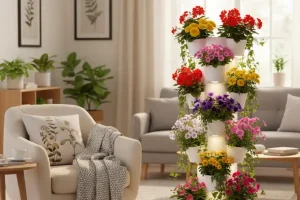A living wall is more than just a garden—it’s a statement piece. With flowers cascading down a vertical surface, you can transform a blank balcony wall, patio fence, or indoor partition into a lush, colorful display. The best part? By planning with the seasons in mind, you can enjoy fresh waves of blooms all year long.
This guide will walk you through the essentials of designing, planting, and maintaining a living wall filled with seasonal flowers.
Why Living Walls Are Worth It
Living walls turn unused vertical surfaces into productive, beautiful spaces. They add color, texture, and a soft, natural feel without crowding your floors or furniture.
Living walls turn unused vertical surfaces into productive, beautiful spaces. They add color, texture, and a soft, natural feel without crowding your floors or furniture.
- Space-saving: Perfect for small apartments, patios, or urban settings. A single wall panel can replace several pots, freeing up counters and windowsills. Modules are slim and lightweight, so they fit hallways, balconies, and tight corners.
- Year-round beauty: With simple seasonal planning, there’s always something blooming or looking fresh. Use a backbone of evergreen foliage, then rotate flowering pockets by season for quick, affordable updates.
- Environmental benefits: Plants help filter indoor air, add gentle humidity in dry rooms, and can lower heat when placed on sunny walls by shading and cooling the surface. A dense living wall also offers a bit of sound absorption and insulation.
- Well-being: Surrounding yourself with greenery reduces stress and boosts mood. Many people report better focus, calmer rooms, and a more welcoming feel for guests and work calls.
- Easy maintenance options: Self-watering inserts or simple drip kits keep care low. A weekly check for moisture, pruning, and deadheading is often enough.
- Flexible design: Start small with one panel and expand over time. Mix foliage textures and a few bloomers for a polished, high-impact look without constant replanting.
In short, living walls deliver big style and daily benefits in a small footprint—ideal for renters, homeowners, and anyone craving a little more nature indoors.
In short, living walls deliver big style and daily benefits in a small footprint—ideal for renters, homeowners, and anyone craving a little more nature indoors.
Step 1: Choose Your Structure
There are several ways to build a living wall, depending on your budget and space.
- Modular panel systems: Pre-made panels with pockets for plants. Easy to maintain and swap plants out seasonally.
- Hanging pocket organizers: Affordable and simple, ideal for small spaces.
- Custom-built frames: A wooden or metal grid lined with landscape fabric. Best for large outdoor walls.
- Freestanding vertical planters: Great for renters since they don’t require attaching anything to walls.
Step 2: Plan for Seasonal Rotations
The secret to continuous blooms is planting in rotations so one group of flowers fades just as another begins.
Spring blooms: Pansies, petunias, snapdragons, primroses.
Summer blooms: Marigolds, geraniums, zinnias, nasturtiums.
Fall blooms: Chrysanthemums, violas, asters.
Winter blooms (mild climates or indoors): Cyclamen, ornamental kale, hardy pansies.
Step 3: Select the Right Plants
Choose plants with similar sunlight and watering needs for each section of the wall.
- Full sun flowers: Petunias, marigolds, zinnias.
- Partial shade flowers: Impatiens, begonias, fuchsias.
- Trailing varieties: Ivy geraniums, lobelia, nasturtiums for cascading effects.
- Compact plants: Pansies, violas, and snapdragons for filling pockets.
Step 4: Soil and Watering Setup
Living walls dry out faster than ground gardens, so moisture management is key.
- Use lightweight, well-draining potting mix.
- Add slow-release fertilizer for steady feeding.
- Install a drip irrigation system or use self-watering planters for consistency.
- Ensure proper drainage to prevent root rot.
Step 5: Design for Visual Impact
Think of your living wall as a piece of art.
- Color blocking: Group flowers by color for bold, eye-catching sections.
- Layering: Mix trailing and upright plants for depth.
- Seasonal accents: Swap out annuals each season for fresh displays.
- Symmetry or free-form: Choose a design that fits your style—structured or flowing.
Quick Seasonal Planting Table
| Season | Suggested Flowers | Notes |
| Spring | Petunias, pansies, snapdragons | Bright, cool-season colors |
| Summer | Marigolds, geraniums, zinnias | Heat-tolerant and vibrant |
| Fall | Chrysanthemums, violas, asters | Rich autumn tones |
| Winter | Cyclamen, ornamental kale, hardy pansies | Works in mild climates or indoors |
Common Mistakes to Avoid
- Planting incompatible flowers together
Always group flowers with similar light and water needs. - Overwatering
Living walls can suffer from soggy pockets if drainage isn’t managed. - Ignoring seasonal swaps
Annuals fade with the seasons. Replace them to keep your wall fresh. - Neglecting wall protection
Protect outdoor walls with a waterproof barrier before installing your structure.
FAQs
Q: Can I grow a living wall indoors?
Yes. Use pocket planters or modular panels near a bright window, or add grow lights for indoor blooms.
Q: How often do I need to replace plants?
Annuals need replacing seasonally. Perennials can last several years with proper care.
Q: Do living walls damage walls?
Not if installed properly. Always use a waterproof liner or barrier between the wall and your planter system.
Q: Can I mix flowers with herbs in the same wall?
Yes, as long as they share similar care needs. For example, basil pairs well with marigolds.
Next Steps & Related Reading
If you’d like specific flower care guidance, see Year-Round Care for Vertical Garden Petunias and Pansies.
For system upkeep, explore the Seasonal Maintenance Checklist for Vertical Growing Systems.
Conclusion
A living wall of seasonal blooms is a stunning way to bring color, freshness, and nature into your home year-round. By choosing the right structure, rotating seasonal flowers, and maintaining consistent soil and watering practices, you’ll enjoy a vertical garden that looks beautiful in every season.
Would you prefer your living wall to follow bold color themes or a natural mix of seasonal varieties?




